|
Cooper-Craft 4mm wooden-bodied vans – an introduction
by Graeme Pettit
Introduction
These are straightforward and well-designed kits to build. Spares are available to ring the changes in type. Many of the kits contain alternative roofs, and packs of alternative ends are also available as extras.
Early versions of these kits were supplied with plastic wheelsets, and with some of these the floor didn't fit as it wasn't wide enough. However, metal wheelsets and brass bearings are now included with the kits, and packing strips for producing the correct floor width have been included.
I recommend Mek-Pak or Plastic Magic glue for assembly. Humbrol Liquid Poly will also do quite well, but is slower to go off in my experience – especially if over applied – and the pear drop smell gives me a headache. All glues should be used in a well ventilated place, and do not smoke when the cap is off!
|
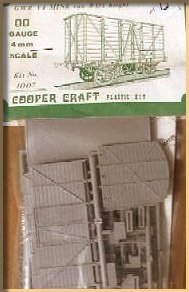 |
GWR wooden Mink van diagram V5 (kit 1003)
After the abandonment of iron construction for van building (the diagram V6 Iron Minks), a new design of wooden van was sought.
The first design was diagram V5, built 1902–1904 (the diagrams were not listed in chronological order). The V5s were built on a 16' underframe with a 7' inside height. They had DCI brake gear, with brake shoes on one side only.
As originally built, the V5s had a single central unlouvred bonnet for ventilation.
|
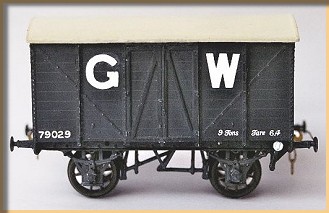
Diagram V5 79029, built by Mikkel Kjartan |
GWR wooden Mink vans diagram V4 (kits 1007 & 1008)
Following on from the V5 diagram, from 1904–1906 a slightly wider van type was built in two different heights and given the V4 diagram.
There are Cooper-Craft kits for both the V4 height varieties, namely 8'0½" high (178 built, kit 1007) and 7'6½" high (22 built, kit 1008).
Two designs of roof are available with the kit – a ribbed design, representing the steel roof, and a plain design, representing the standard canvas covered wooden roof design.
|
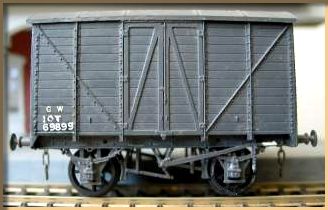
Diagram V4 – this is the 8'0½ " high version |
V4/V5 variations
After 1906, some of the V4s and V5s were fitted with end louvres to cater for perishable traffic, such as fruit, flowers, vegetables, fish and meat. Such vans, used in express freight, were designated 'Mink A'. In 1912, the next development was to utilise a double bonnet vent. This latter design replaced the older style ends on rebuilding or replanking – although many of the louvre vented vans continued to see useful service until nationalisation in 1948. Cooper-Craft has alternative end kits to cater for these changes (kit 1017 for louvred vents and kit 1018 for double bonnet vents), as well as complete kits to cover for the 'Mink A' versions of the V4 (kit 1027 for the high version and kit 1028 for the lower version).
You can ring the changes with brake gear too, as some of these vans were DC fitted, some either side fitted, and some vacuum fitted – just work from a suitable photo of your chosen prototype.
Webmaster's note on V4 and V5 brakes
Initial V4s (the 8'0½" high ones) were built with non-vacuum DCI brake, and later V4s (the 7'6½" high ones) seem to have had vacuum-fitted DCII clasp brakes. V5s were built with DCI brakes. Cooper-Craft kits do not feature the DCI lever, and do not feature clasp brakes, so cannot portray any V4 or V5 accurately unless modifications and additions are made. The lever brake on the chassis sprue is intended primarily for the 4-plank open wagon kit, but can be used if incorporating and depicting a DCI 3-shoe arrangement, as possibly found on some early-build V4s from the mid-1920s onwards.
V4/V5 conversions
One of the most useful variations to these kits which can be made, is to utilise Cooper-Craft's own van end packs for expanding the range.
Kit 1017 contains louvre shutter ends and kit 1018 contains the twin bonnet vent type. The original kits have cross braced ends, and single vents are also provided, so around the basic three kits (i.e. 1003, 1007 and 1008) you have around 12 options.
Add to this the various underframe options, eg DCI or DCIII brakes, single- or dual-sided brakes, Morton braked vans, vacuum-fitted or non-fitted vans etc, and many alternatives are possible. Following the different types can be hard, as many variants exist. So I suggest you fill your spares box, and get reading!
The alternative end packs can, for example, provide the basis for a simple kit conversion from the low V4 to the unfitted and fitted V12 vans. The V12s can then be further modified to those converted with vacuum brakes for Fish traffic to diagram V13 (reclassified diagram S2 in 1927 after many modifications to sides and ends).
Other straightforward conversions from the low V4 include diagrams V14, V16 and V18. An example of a V14 is shown adjacent. Finally, the range of V diagram series vans can be further enhanced by using end panels from other manufacturers to give later designs.
|
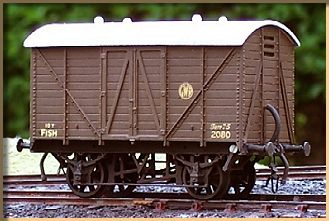
Fish Van diagram S2, converted by Richard Spratt from a Cooper-Craft Mink and fitted with various extras.
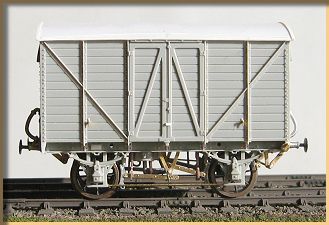
Diagram V14 van, converted by Trevor Pott from the Cooper-Craft low V4 using many extra detailing parts. |
Suggested reading:
- Atkins, Beard & Tourret: 'GWR Goods Wagons', Tourret Publishing 1999
- J. Hayes "GWR Vans to Dia. V12 & V14 from Cooper-Craft Kits – Parts 1 & 2" Model Railway Journal Nos 113 & 114, 1999
Please note: The author has no affiliation with Cooper-Craft.
|




